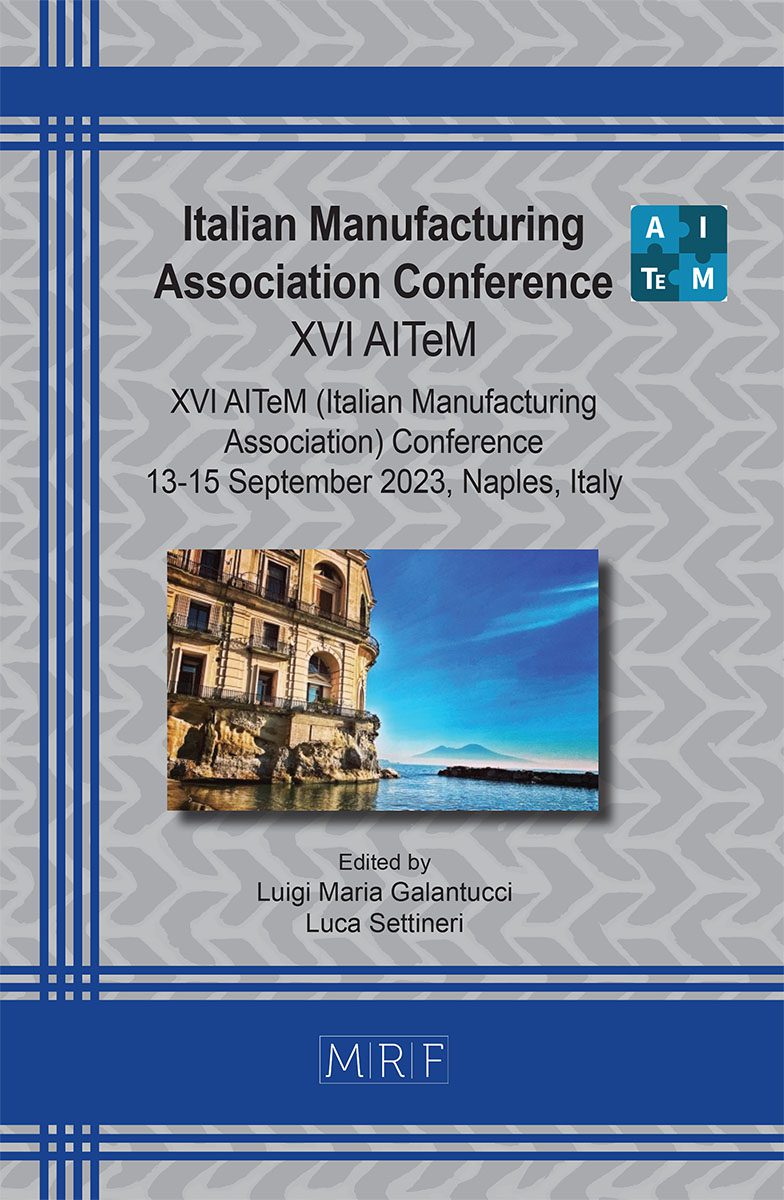Effect of process parameters on the thermal properties of material extruded AM parts
Luigi Morfini, Nicola Gurrado, Roberto Spina
download PDFAbstract. This research focuses on the thermal characterization of 3D-printed parts obtained via Material Extrusion Additive Manufacturing using various process parameters. Differential Scanning Calorimetry and Thermal Conductivity measurements were used to evaluate the samples’ thermal characteristics and heat transport behavior. The experimental results showed a significant influence of some parameters, such as wall layer count and layer thickness, on the thermal behavior of the printed part.
Keywords
Material Extrusion, Quality Control, Thermal Properties
Published online 9/5/2023, 7 pages
Copyright © 2023 by the author(s)
Published under license by Materials Research Forum LLC., Millersville PA, USA
Citation: Luigi Morfini, Nicola Gurrado, Roberto Spina, Effect of process parameters on the thermal properties of material extruded AM parts, Materials Research Proceedings, Vol. 35, pp 225-231, 2023
DOI: https://doi.org/10.21741/9781644902714-27
The article was published as article 27 of the book Italian Manufacturing Association Conference
![]() Content from this work may be used under the terms of the Creative Commons Attribution 3.0 license. Any further distribution of this work must maintain attribution to the author(s) and the title of the work, journal citation and DOI.
Content from this work may be used under the terms of the Creative Commons Attribution 3.0 license. Any further distribution of this work must maintain attribution to the author(s) and the title of the work, journal citation and DOI.
References
[1] L.M. Galantucci, M.G. Guerra, M. Dassisti, F. Lavecchia, Additive Manufacturing: New Trends in the 4th Industrial Revolution, in Lecture Notes in Mechanical Engineering, Springer International Publishing, 2019: pp. 153-169. https://doi.org/10.1007/978-3-030-18180-2_12
[2] J.M. Chacón, M.A. Caminero, E. García-Plaza, P.J. Núñez, Additive manufacturing of PLA structures using fused deposition modelling: Effect of process parameters on mechanical properties and their optimal selection, Mater Des. 124 (2017) 143-157. https://doi.org/10.1016/j.matdes.2017.03.065
[3] L. Auffray, P.A. Gouge, L. Hattali, Design of experiment analysis on tensile properties of PLA samples produced by fused filament fabrication, International Journal of Advanced Manufacturing Technology. 118 (2022) 4123-4137. https://doi.org/10.1007/s00170-021-08216-7
[4] S.H. Ahn, M. Montero, D. Odell, S. Roundy, P.K. Wright, Anisotropic material properties of fused deposition modeling ABS, Rapid Prototyp J. 8 (2002) 248-257. https://doi.org/10.1108/13552540210441166
[5] S.F. Costa, F.M. Duarte, J.A. Covas, Estimation of filament temperature and adhesion development in fused deposition techniques, J Mater Process Technol. 245 (2017) 167-179. https://doi.org/10.1016/j.jmatprotec.2017.02.026
[6] F. Bähr, E. Westkämper, Correlations between Influencing Parameters and Quality Properties of Components Produced by Fused Deposition Modeling, in: Procedia CIRP, Elsevier B.V., 2018: pp. 1214-1219. https://doi.org/10.1016/j.procir.2018.03.048
[7] S. Garzon-Hernandez, D. Garcia-Gonzalez, A. Jérusalem, A. Arias, Design of FDM 3D printed polymers: An experimental-modelling methodology for the prediction of mechanical properties, Mater Des. 188 (2020). https://doi.org/10.1016/j.matdes.2019.108414
[8] N. Zohdi, R.C. Yang, Material anisotropy in additively manufactured polymers and polymer composites: A review, Polymers (Basel). 13 (2021). https://doi.org/10.3390/polym13193368
[9] C. Shemelya, A. De La Rosa, A.R. Torrado, K. Yu, J. Domanowski, P.J. Bonacuse, R.E. Martin, M. Juhasz, F. Hurwitz, R.B. Wicker, B. Conner, E. MacDonald, D.A. Roberson, Anisotropy of thermal conductivity in 3D printed polymer matrix composites for space based cube satellites, Addit Manuf. 16 (2017) 186-196. https://doi.org/10.1016/j.addma.2017.05.012
[10] S.Y. Chung, D. Stephan, M.A. Elrahman, T.S. Han, Effects of anisotropic voids on thermal properties of insulating media investigated using 3D printed samples, Constr Build Mater. 111 (2016) 529-542. https://doi.org/10.1016/j.conbuildmat.2016.02.165
[11] D. Ravoori, L. Alba, H. Prajapati, A. Jain, Investigation of process-structure-property relationships in polymer extrusion based additive manufacturing through in situ high speed imaging and thermal conductivity measurements, Addit Manuf. 23 (2018) 132-139. https://doi.org/10.1016/j.addma.2018.07.011
[12] H. Prajapati, D. Ravoori, R.L. Woods, A. Jain, Measurement of anisotropic thermal conductivity and inter-layer thermal contact resistance in polymer fused deposition modeling (FDM), Addit Manuf. 21 (2018) 84-90. https://doi.org/10.1016/j.addma.2018.02.019
[13] S. Wang, D. Zhang, G. Liu, W. Wang, M. Hu, Application of hot-wire method for measuring thermal conductivity of fine ceramics, Medziagotyra. 22 (2016) 560-564. https://doi.org/10.5755/j01.ms.22.4.12543
[14] M. Ruoho, K. Valset, T. Finstad, I. Tittonen, Measurement of thin film thermal conductivity using the laser flash method, Nanotechnology. 26 (2015). https://doi.org/10.1088/0957-4484/26/19/195706
[15] R. Spina, Performance analysis of colored PLA products with a fused filament fabrication process, Polymers. 11 (2019). https://doi.org/10.3390/polym11121984
[16] J. Gaiser, M. Stripf, F. Henning, Enhanced Transient Hot Bridge Method Using a Finite Element Analysis, Int J Thermophys. 40 (2019). Https://doi.org/10.1007/s10765-018-2476-y
[17] U. Hammerschmidt, V. Meier, New transient hot-bridge sensor to measure thermal conductivity, thermal diffusivity, and volumetric specific heat, Int J Thermophys. 27 (2006) 840-865. https://doi.org/10.1007/s10765-006-0061-2
[18] O. Ozdilli, Comparison of the Surface Quality of the Products Manufactured by the Plastic Injection Molding and SLA and FDM Method, Uluslararası Muhendislik Arastirma ve Gelistirme Dergisi. (2021) 428-437. https://doi.org/10.29137/umagd.762942












